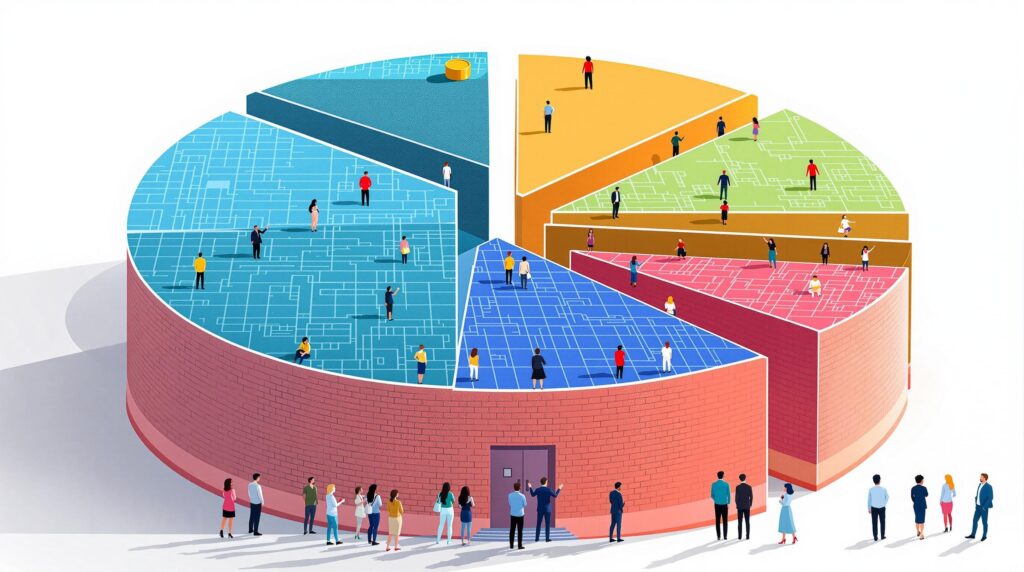[rev_slider alias=”slider-1″][/rev_slider]
The Rise of Layer 1 Blockchains
The evolution of Layer 1 blockchains has been remarkable in the world of Web3. These core protocols serve as the backbone of blockchain technology, supporting decentralized apps and smart contracts. With the increasing demand for decentralized solutions, Layer 1 blockchains have become crucial in enabling the seamless functionality and security of entire ecosystems.
Key Characteristics of Layer 1 Solutions
Layer 1 blockchains possess unique characteristics that differentiate them from Layer 2 solutions. These include their ability to process basic transactions, provide security through consensus algorithms, and serve as platforms for smart contracts without relying on secondary layers. Let’s delve deeper into these attributes:
- Direct Transaction Processing: Layer 1 blockchains handle all transactions on-chain, making them more self-reliant and robust compared to their Layer 2 counterparts.
- Consensus Mechanisms: These blockchains utilize consensus algorithms like Proof of Work (PoW) or Proof of Stake (PoS) to validate transactions and ensure network security.
- Smart Contract Capabilities: They are equipped to host smart contracts, enabling developers to create decentralized applications (dApps) directly on the blockchain.
What is a Layer 1 blockchain? A Layer 1 blockchain is the base layer of a blockchain network, responsible for fundamental features like processing transactions and providing security, without relying on secondary solutions.
Decentralization and Security
The concepts of decentralization and security are at the heart of Layer 1 blockchains. Decentralization ensures that no central authority governs the network, promoting transparency and resilience against manipulation. This is achieved through a network of nodes that validate transactions transparently, preventing any single point of failure.
One significant advantage of these blockchains is their enhanced security architecture. By relying on distributed networks, they reduce risks associated with hacking and data breaches. This secure infrastructure is pivotal for applications handling sensitive information or financial transactions, especially in emerging markets like Africa.
Scalability Challenges
While Layer 1 blockchains bring numerous advantages, scalability remains a notable challenge. As the number of transactions increases, the need for processing power grows, potentially leading to congestion and higher transaction fees. Innovations such as sharding and off-chain solutions are explored to address these issues. However, achieving scalability without compromising security or decentralization remains a complex endeavor.
“Your Voice, Our Mission” – we champion your rights with the tenacity and dedication that has earned us the trust of our community members.
Jara’s Role in the Blockchain Ecosystem
Jara stands as a pioneering force by leveraging blockchain technology to fuel Africa’s digital economy. With the $JARA token, it offers a vertically integrated platform that transforms African assets into global digital investments.
- Layer 2 Integration: Jara’s proprietary Layer 2 blockchain boosts transaction speed and reduces costs, ensuring an efficient and scalable solution for tokenized assets.
- Tokenization Projects: Initiatives like the Lagos airport tokenization exemplify Jara’s capability to unlock infrastructure investments previously inaccessible to many.
- Community Engagement: By integrating social features and AI influencers, Jara fosters an active community environment focused on education and growth.
Layer 1 blockchains play a pivotal role in shaping the future of decentralized technology, driven by the need for more secure, scalable, and transparent solutions. Jara, with its innovative approach, is well-positioned to lead this transformation, connecting Africa’s booming economic landscape with global capital through its digital infrastructure initiatives. Explore more about Jara’s mission to reshape the financial services sector across emerging markets.
Advantages and Challenges of Layer 1 Blockchains
In the rapidly evolving world of blockchain technology, Layer 1 blockchains stand out due to their unique capabilities. Designed to provide a foundation for decentralized applications (dApps) and supporting technologies, Layer 1 blockchains offer significant advantages. Yet, they face equally compelling challenges that must be addressed to ensure their future role as a pillar of Web3 technology, especially in transforming Africa’s digital economy.
Security and Decentralization: Layer 1 blockchains are hailed for their robust security measures and the decentralized nature of their operations. This ensures that no single entity has control over the network, enhancing trust among users. But what exactly drives this security? Primarily, it’s the use of consensus mechanisms like Proof of Work (PoW) and Proof of Stake (PoS), which guide the validation of transactions and block creation.
Why are Layer 1 blockchains considered secure? They utilize complex consensus mechanisms like Proof of Work (PoW) and Proof of Stake (PoS) to secure transactions and maintain decentralization across their networks.
Transparency and Immutability: One of the hallmark features of Layer 1 blockchains is their transparency. All transactions are recorded on a public ledger, allowing anyone to track and verify data directly. This degree of transparency contributes to the blockchain’s immutability, meaning once a transaction is recorded, it cannot be altered. This provides a new level of accountability that is vital for applications in sectors like finance and governance.
However, it’s not all smooth sailing. Layer 1 blockchains encounter two profound challenges:
Scalability and Energy Consumption Analysis
Scalability Issues: The ability to handle a growing amount of transactions per second (TPS) remains a critical hurdle for Layer 1 blockchains. As the demand for blockchain services increases, these networks struggle to maintain speed and efficiency. The term ‘scalability’ in the blockchain lexicon refers to the capacity to grow and manage increased demand without compromising performance.
What is scalability in blockchains? Scalability is the capability of a blockchain network to handle a growing number of transactions per second without reducing performance or security.
While Layer 1 networks like Bitcoin and Ethereum were pioneering in bringing blockchain technology to the forefront, they are sometimes hampered by their original designs. Innovations such as sharding and Layer 2 solutions are being explored to combat these limitations.
Energy Consumption: High energy consumption is another pressing issue linked to Layer 1 blockchains, particularly those using PoW algorithms. These blockchains require significant computational power which, in turn, leads to increased electricity usage. Such high consumption has spotlighted environmental concerns and increased advocacy for greener alternatives.
What are the energy concerns with Layer 1 blockchains? Blockchains using Proof of Work (PoW) spend large amounts of energy due to the computational power needed for mining and validating transactions.
How do we continue innovating in this space? By adopting alternative consensus mechanisms that are both efficient and eco-friendly, blockchain developers can strike a balance between operational demands and sustainability. These innovations are not just necessary for growth but also for aligning with global environmental standards.
In Africa, where digital transformation is essential, particularly innovative solutions driven by entities like Jara are setting the stage. The integration of Layer 2 solutions within the Jara ecosystem, presents a unique opportunity to harness Layer 1 blockchains’ power while mitigating their limitations. Jara’s combined strategy leverages AI-powered resources and socially integrated frameworks, fostering a comprehensive digital economy adaptable to the continent’s unique requirements.
[rev_slider alias=”text-call-cta”][/rev_slider]
Layer 2 Solutions: Complementing or Competing?
Layer 2 solutions have emerged as pivotal complements to Layer 1 blockchains. By building on top of the foundational network laid by Layer 1, Layer 2 technologies focus on tackling the limitations inherent in their predecessors, such as transaction speed and cost inefficiencies. So, what are the main benefits of Layer 2? They enhance scalability, lower transaction fees, and increase throughput, making blockchain more accessible and efficient for widespread adoption.
Layer 2 solutions supplement Layer 1 blockchains by improving transaction speed and lowering costs, addressing scalability challenges for wider blockchain usability.
Integration with Layer 1 Blockchains
The synergy between Layer 1 and Layer 2 solutions is critical for realizing the full potential of blockchain technology. Layer 1 blockchains like Bitcoin and Ethereum provide the secure, decentralized backbone that Layer 2 solutions rely upon. However, these foundational networks often face bottlenecks as they scale, particularly with high transaction volumes.
Layer 2 solutions act as the icing on the cake, handling off-chain transactions which are later settled on Layer 1 to ensure security and decentralization are maintained. This architecture significantly alleviates network congestion and enhances user experience, providing faster confirmation times and reduced transaction fees. For instance, Ethereum’s Layer 2 solutions, such as Optimistic Rollups and zk-Rollups, allow for thousands of transactions per second compared to the relatively slower native Ethereum network.
Prominent Layer 2 Solutions
There are several noteworthy Layer 2 solutions currently enhancing blockchain networks. Let’s take a closer look:
- Optimistic Rollups: These rollups increase Ethereum’s transaction throughput by bundling multiple transactions and processing them off-chain before posting a single transaction to Layer 1 for validation.
- zk-Rollups: Zero-Knowledge rollups offer a more privacy-focused solution by allowing transactions to be verified through cryptographic proofs without revealing transaction details.
- State Channels: This solution enables participants to conduct transactions off-chain and only broadcast finality in the form of a consensus to the blockchain, reducing the load on the main network.
Layer 2 solutions like Optimistic and zk-Rollups significantly increase transaction throughput and reduce costs, crucial for mainstream blockchain adoption.
Real-World Applications in Africa
Africa stands at the frontier of embracing blockchain’s transformative potential, largely due to the need for effective and inclusive financial solutions. Layer 2 solutions have the capacity to address inefficiencies in Africa’s digital infrastructure by providing scalable and cost-effective transaction methods. Jara, for example, epitomizes these principles by leveraging a proprietary Layer 2 blockchain to facilitate tokenized investment opportunities, bridging the gap between local projects and global capital.
Enabled by $JARA tokens, participants can engage in a decentralized economy where they benefit from reduced transaction fees and increased transaction speeds, crucial components for economic growth and financial inclusion across the continent. The synergy of Layer 1 and Layer 2 technologies fosters a robust ecosystem capable of handling diverse applications from peer-to-peer transactions to large-scale infrastructure investment projects.
Jara utilizes Layer 2 blockchain solutions to drive financial inclusion in Africa, enabling access to global capital for local development projects efficiently.
Future Outlook: Collaboration or Competition?
With the evolving landscape of blockchain technology, the question arises: Is there more collaboration or competition between Layer 1 and Layer 2 solutions? Ideally, collaboration surpasses competition, as both layers fulfill distinct yet interdependent roles in the ecosystem. While Layer 1 provides security and decentralization, Layer 2 enhances efficiency and scalability, akin to refining raw ingredients into a gourmet meal.
Going forward, the continued development and integration of Layer 2 solutions will likely enhance the robustness of blockchain platforms. This will facilitate the growth of cutting-edge applications that can cater to diverse sectors, from finance to supply chain management, particularly across resource-rich regions like Africa. By supporting and integrating Layer 2 solutions, blockchain platforms are poised to become the cornerstone of the next generation digital economy.
The collaboration between Layer 1 and Layer 2 solutions paves the way for advanced, scalable blockchain applications that cater to various global markets.
The Future of Web3 with Layer 1 and Layer 2 Solutions
The transformation of Web3 hinges significantly on the breakthrough developments of Layer 1 and Layer 2 blockchain solutions. These technologies promise to overcome existing limitations, offering a path to faster, more secure, and scalable decentralized applications (dApps). As these innovations continue to mature, they are poised to become the backbone of the Web3 ecosystem, revolutionizing how digital contents and assets are managed and transferred across the internet.
Potential Innovations and Market Impact
In the rapidly evolving blockchain landscape, new innovations are on the horizon that could drastically alter market dynamics. The enhanced capabilities of Layer 1 blockchains, such as increased transaction speeds and improved security protocols, are central to broadening the adoption of decentralized networks. On the other hand, Layer 2 solutions aim to solve scalability issues without sacrificing security, effectively bridging the gap between demand and operational capacity.
What distinguishes Layer 1 from Layer 2? Layer 1 blockchains form the base layer of the blockchain network, enabling fundamental functions such as consensus mechanisms, while Layer 2 solutions are built atop Layer 1 to enhance scalability and speed.
As more developers and companies adopt these technologies, the market is expected to see a ripple effect across various industries. From finance and supply chain to healthcare and entertainment, the integration of blockchain solutions offers unprecedented decentralization and efficiency, leading to enhanced trust and transparency in every transaction.
- Financial Services: The use of Layer 1 and Layer 2 solutions can significantly reduce transaction costs and increase transparency in financial transactions, making financial services more accessible to underserved populations.
- Supply Chain Management: Blockchain technology can ensure the traceability and authenticity of goods, which is invaluable in complex supply chains that span multiple countries.
- Healthcare: Securely sharing patient data between providers across different platforms while maintaining privacy is possible with blockchain’s decentralized nature.
The true potential of these technologies can be unleashed through continued developments and strategic partnerships. For instance, collaborations can foster emerging use cases that leverage the strengths of both Layer 1 and Layer 2, ultimately leading to robust ecosystems that cater to diverse applications, including the unlocking of tokenized real-world assets.
“Invest in $JARA today and become part of Africa’s digital future.” – These are the words that capture the transformative impact the Jara ecosystem aims to have on the digital asset economy in Africa via our proprietary Layer 2 blockchain solution.
The implications for market expansion are vast, particularly in regions with untapped potential like Africa. By building infrastructure that facilitates seamless access to global capital, projects like Jara are paving the way for economic empowerment and inclusion. With a focus on bridging traditional markets with cutting-edge technology, the possibilities are virtually limitless.
What’s next for industries adopting blockchain technology? As they continue to innovate, these sectors must address not only the technical challenges but also regulatory hurdles that might impede full-scale implementation. Nevertheless, the inherent benefits of blockchain, when creatively harnessed, could lead to the emergence of a more connected, efficient, and decentralized global economy.
“The power of $JARA and its strategic position at the heart of Africa’s digital transformation is not just an investment opportunity; it’s a chance to partake in shaping the future of commerce across the continent.”
[rev_slider alias=”schedule-consultation-btn”][/rev_slider]

Is Layer 1 blockchain scalable for large networks?
Layer 1 blockchains face scalability issues due to their consensus algorithms. This results in slower transaction processing and higher energy consumption, limiting their ability to efficiently handle large volumes of data. Innovations in consensus mechanisms are essential for overcoming these challenges.
How do Layer 2 solutions enhance Layer 1 blockchains?
Layer 2 solutions enhance Layer 1 blockchains by providing additional layers for transaction processing. They focus on offloading transactions from the main chain to improve speed and reduce costs, thus optimizing the overall performance and user experience of blockchain networks.
What security measures do Layer 1 blockchains employ?
Layer 1 blockchains employ robust security measures through their consensus algorithms. These include Proof of Work (PoW) or Proof of Stake (PoS), ensuring transparency, immutability, and resistance to modifications. The levels of security depend on the algorithm’s complexity and implementation.
Can Layer 1 and Layer 2 solutions coexist on the same platform?
Yes, Layer 1 and Layer 2 solutions can coexist on the same platform. Layer 2 acts as an extension to Layer 1, managing transactions and enhancing performance without altering the core blockchain’s protocols. Their synergy is essential in advancing technologies within the Web3 ecosystem.

Additional Pages Related to Layer 1 Blockchains
Explore additional pages that delve into various aspects related to Layer 1 blockchains, extending your understanding of this transformative technology:
Hear From Our Satisfied Clients
Serving our Layer 1 and Layer 2 blockchain solutions clients with complete dedication, every case reflects our commitment to excellence. The positive feedback we receive underscores our consistent hard work and dedication.

[rev_slider alias=”slider-3″][/rev_slider]
[rev_slider alias=”slider-6″][/rev_slider]
Discover the Power of Jara: Your Gateway to Blockchain Solutions
The digital revolution is here, and Jara is at the forefront, bridging global capital to African assets with innovative Layer 1 and Layer 2 blockchain solutions. But don’t just take our word for it; our accomplishments speak volumes.
Start your journey with Jara and explore the future of Web3 with the leaders recognized for excellence in blockchain innovation.
- Innovation in Blockchain Applications: Featured among the “Top Blockchain Innovators” in 2023 by TechCrunch.
See the list. - Excellence in Decentralized Technologies: Listed as one of the “Leading Decentralized Solution Providers” by Decentral Magazine, 2023.
Explore here. - Pioneering Digital Finance: Recognized by FinTech Review as a “Top FinTech Leader” 2023.
Read more. - Trailblazers in Web3 Development: Celebrated among the “Top Web3 Developers” by Blockchain News, 2023.
Check it out. - Advocates for Sustainable Technology: Highlighted in GreenTech’s 2023 “Innovative Sustainable Solutions” list.
View the list.
Contact us at [email protected] or download the Jara app on Android or iPhone to begin your transformative blockchain journey today. Embrace the future with Jara!
Chinyere “Chi” Nnadi Bio
Founder and CEO, Jara | Leading Blockchain Innovator
Content reviewed by Chi Nnadi and his content team. Chi is an experienced entrepreneur dedicated to transforming Africa’s financial ecosystem through blockchain technology. As Founder and CEO of Jara, he builds enterprise-grade infrastructure to convert illiquid African assets into globally accessible digital tokens. With his innovative blockchain expertise, Chi bridges the gap between global investors and Africa’s burgeoning digital asset market.
Our Content Review Process
Chi Nnadi along with Jara’s dedicated content team, pledge to offer top-notch material. Our content guidelines ensure thoroughness, reputable sources, unbiased scrutiny, among other quality metrics. Please let us know if there is anything you believe to be inaccurate.
















